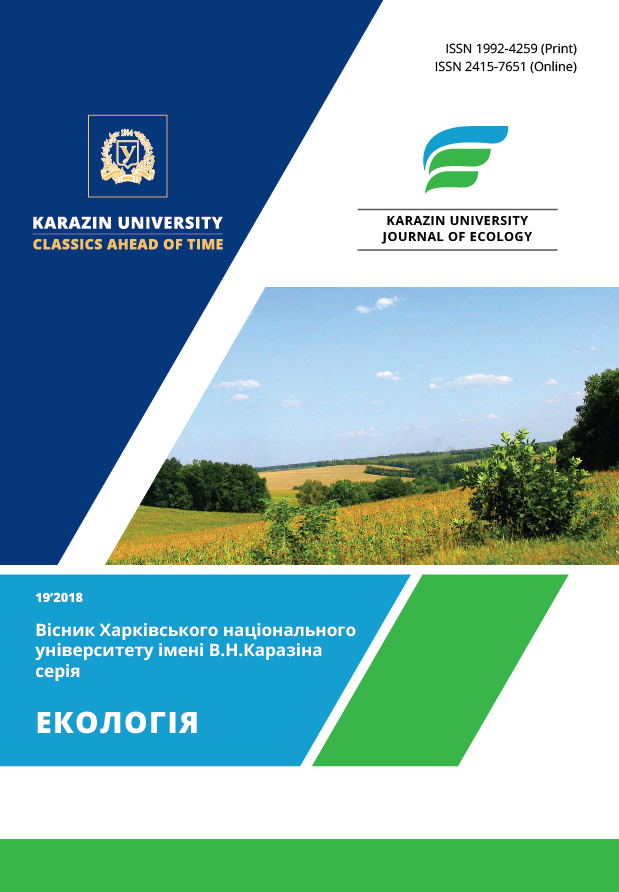Mesozooplankton study in Odessa bay in 2016-2017
Keywords:
mesozooplankton, taxonomic composition, number, biomass, biodiversity,Abstract
Purpose. Study of the current state of mesozooplankton in Odessa Bay coastal waters, 2016-2017. Methods. Standard methods of sampling, determination of mesozooplankton species composition, number and biomass. Results. Mesozooplankton sampled every 10 days and monthly in the area of the University Hydrobiological Station has been studied, taxonomic composition, number and biomass of each species determined; the results have been analysed and presented. Mesozooplankton biodiversity indices have been assessed in the coastal waters. Seasonal changes in number and biomass of the main mesozooplankton groups have been studied. Two zooplankton sampling methods have been compared. Marine environment quality has been assessed using the metrics of mesozooplankton. Altogether 31 and 22 taxa belonging to 9 main mesozooplankton groups have been identified in 2016 and 2017 respectively. The dominant groups were Copepoda, Rotatoria, Protozoa, Cladocera and Harpacticoida. Mesozooplankton number and biomass in 2016-2017 varied within broad limits from 600 ind./m³ and 0.24 mg/m³ (10.03.2017) to 225920 ind./m³ (10.06.2017) and 5471.96 mg/m³ (29.06.2017). Significant differences in the values of mesozooplankton number and biomass were revealed through sampling at the stations with different depth, which can be explained by both spatial inhomogeneity and different vertical distribution of those characteristics due to the features of the vertical distribution of temperature and salinity with depth. It was established that in shallow areas sampling with Juday net was more effective and representative than sampling with modified Apstein net. Analysis of marine environmental quality assessments using three different metrics of mesozooplankton has shown that the method of quality assessment using biomass was the most representative. Conclusions. Marine environment quality was assessed mainly as «Bad» and «Very Bad» for 82% of samples, «Good» and «High» for 4%, «Moderate» for 14% of samples. The performed assessment proves unsatisfactory conditions for mesozooplankton community normal development and functioning in Odessa Bay coastal waters.References
Грузов Л.Н., Люмкис П.В., Нападовский Г.В. Исследования пространственно-временной структуры планктонных полей северной половины Черного моря в 1992-1993 гг. Исследование экосистемы Чер-ного моря. / под ред. В.И. Мединца. Одеса, 1994. С. 94-113.
Зайцев Ю.П., Александров Б.Г., Миничева Г.Г. и др. Северо-западная часть Черного моря: биология и экология. Киев: Наукова думка, 2006. 701 с.
Киселев И.А. Методы исследования планктона. В кн.: Жизнь пресных вод СССР. Л.: Изд-во АН СССР, 1956. Т. 4, вып. 1. С. 183-265
Воробьева Л.В., Кулакова И.И., Синегуб И.А. и др. Одесский регион Черного моря: гидробиология пелагиали и бентали: монография / отв. ред. Б.Г. Александров. Одесса: Астропринт, 2017. 324 с.
Aleksandrov B., Arashkevich E., Gubanova A., Korshenko A. Black Sea monitoring guidelines: mesozoo-plankton. Publ. EMBLAS Project, BSC, 2014. 31 p.
Moncheva S., Boicenco L. (Eds). State of Environment Report of the Western Black Sea based on Joint MISIS cruise. MISIS Joint Cruise Scientific Report, 2014. 401 p.
Stefanova К., Stefanova E., Doncheva V. A classification system for evaluation of ecological status of coastal marine waters in respect of zooplankton biological element of quality: Proceeding of «Seminar of ecology – 2015 with international participation», 23-24.04.2015. – Sofia, Bulgaria, 2016. P. 231-240.
Проект UNDP- EU «Поліпшення моніторингу довкілля Чорного моря, Фаза 2 - EMBLAS-II» (2015-2018). URL:http://www.emblasproject.org
Определитель фауны Черного и Азовского морей. Киев: Наукова думка, 1968.Т.1. 437 с.
Определитель фауны Черного и Азовского морей. Киев: Наукова думка, 1969. Т.2. 536 с.
Кожова О.М. Инструкция по обработке проб планктона счетным. Иркутск, 1978. С. 3-18.
Ковальова Н.В., Медінець В.І., Мілева А.П., Ботнар М.Г., Снігірьов С.М., Газєтов Є. І., Медінець С.М. Порівняльна оцінка якості прибережних морських вод Одеської затоки і району острову Зміїний в 2016 р. Вісник ХНУ імені В.Н. Каразіна, Серія: «Екологія», 2017. Вип. 16. С. 132-140.
Берлинский Н.А., Попов Ю.И. Формирование придонной гипоксии и сероводорода на шельфе Черного моря. Вісник ХНУ імені В.Н. Каразіна, Серія «Екологія», 2018. Вип. 18. С. 6-13.
Downloads
Issue
Section
License
Authors reserve the right of attribution for the submitted manuscript, while transferring to the Journal the right to publish the article under the Creative Commons Attribution License. This license allows free distribution of the published work under the condition of proper attribution of the original authors and the initial publication source (i.e. the Journal)Authors have the right to enter into separate agreements for additional non-exclusive distribution of the work in the form it was published in the Journal (such as publishing the article on the institutional website or as a part of a monograph), provided the original publication in this Journal is properly referenced
The Journal allows and encourages online publication of the manuscripts (such as on personal web pages), even when such a manuscript is still under editorial consideration, since it allows for a productive scientific discussion and better citation dynamics (see The Effect of Open Access).

